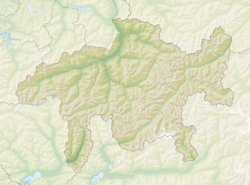Tartar, Switzerland facts for kids
Quick facts for kids
Tartar
|
||
|---|---|---|
|
||
| Country | Switzerland | |
| Canton | Graubünden | |
| District | Hinterrhein | |
| Area | ||
| • Total | 1.58 km2 (0.61 sq mi) | |
| Elevation | 995 m (3,264 ft) | |
| Population | ||
| • Total | 168 | |
| • Density | 106.3/km2 (275.4/sq mi) | |
| Postal code |
7422
|
|
| Surrounded by | Cazis, Masein, Portein, Präz, Sarn | |
Tartar was once a small town, or municipality, in Switzerland. It was located in the Graubünden area, which is a canton (like a state) in Switzerland. On January 1, 2010, Tartar joined with three other towns – Portein, Präz, and Sarn – to become part of a larger town called Cazis. So, Tartar is no longer a separate municipality.
Contents
A Look at Tartar's Past
Tartar is a very old place! People first wrote about it between 1290 and 1298. Back then, it was called in Tartere.
Where Tartar Was Located
Tartar was a small area, about 1.6 square kilometers (0.6 square miles). Imagine a square with sides just over 1.2 kilometers long – that's how big it was!
- A little over half of its land (51.9%) was used for farming.
- About 38% was covered by forests.
- Around 8.2% had buildings or roads.
- The rest (1.9%) was natural land like rivers or mountains.
Tartar was located on the lower Heinzenberg mountains. It sat at an elevation of about 994 meters (3,261 feet) above sea level. The village of Tartar was a haufendorf. This means it was an unplanned village with buildings packed closely together around a central area. It included parts like Oberschauenberg, Valeina, Pro Biet, and the Foppa farmhouses.
Who Lived in Tartar?
In 2007, Tartar had 168 people living there. About 4.8% of these people were from other countries. Over the 10 years before 2007, the number of people living in Tartar went down by 4%.
Age and Gender in Tartar
In 2000, the population was almost evenly split between boys and girls:
- 50.6% were male.
- 49.4% were female.
Here's how old people were in Tartar in 2000:
- 10.8% were children aged 0 to 9 years old.
- 8.9% were kids aged 10 to 14.
- 4.4% were teenagers aged 15 to 19.
- 8.9% were young adults aged 20 to 29.
- 13.3% were adults aged 30 to 39.
- 14.6% were adults aged 40 to 49.
- 13.9% were adults aged 50 to 59.
- 12.7% were seniors aged 60 to 69.
- 6.3% were seniors aged 70 to 79.
- 5.1% were seniors aged 80 to 89.
- 1.3% were seniors aged 90 to 99.
Politics and Education
In the 2007 Swiss national election, the most popular political group in Tartar was the SVP. They received 53.4% of the votes. Other popular groups included the SPS (16.8%), the CVP (15.3%), and the FDP (14.5%).
Many adults in Tartar (about 67.4% of those aged 25-64) had finished more schooling. This included either high school or higher education like university.
Jobs and Work in Tartar
Tartar had a very low unemployment rate of 1.05%. This means almost everyone who wanted a job had one.
In 2005, people in Tartar worked in different types of jobs:
- Primary sector: 7 people worked in farming or forestry. There were 2 businesses in this area.
- Secondary sector: 2 people worked in manufacturing or construction. There was 1 business in this area.
- Tertiary sector: 9 people worked in services, like shops or offices. There were 3 businesses in this area.
Population Changes Over Time
Here's how the number of people living in Tartar changed over many years:
| year | population |
|---|---|
| 1808 | 108 |
| 1850 | 170 |
| 1900 | 146 |
| 1920 | 206 |
| 1950 | 188 |
| 2000 | 158 |
Languages Spoken in Tartar
Most people in Tartar speak German. In 2000, nearly everyone (97.5%) spoke German. A few people also spoke Italian or Romansh.
| Languages | Census 1980 | Census 1990 | Census 2000 | |||
|---|---|---|---|---|---|---|
| Number | Percent | Number | Percent | Number | Percent | |
| German | 98 | 93.3% | 144 | 89.4% | 154 | 97.5% |
| Romanish | 6 | 5.7% | 4 | 2.5% | 1 | 0.6% |
| Italian | 0 | 0.0% | 4 | 2.5% | 3 | 1.9% |
| Population | 105 | 100% | 161 | 100% | 158 | 100% |
See also
 In Spanish: Tartar (Suiza) para niños
In Spanish: Tartar (Suiza) para niños




